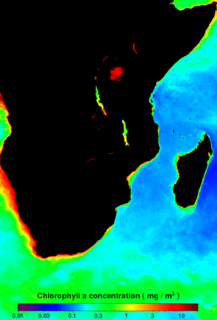
KwaZulu-Natal is a province of South Africa that was created in 1994 when the Zulu bantustan of KwaZulu and Natal Province were merged. It is located in the southeast of the country, with a long shoreline on the Indian Ocean and sharing borders with three other provinces and the countries of Mozambique, Eswatini and Lesotho. Its capital is Pietermaritzburg, and its largest city is Durban. It is the second-most populous province in South Africa, with slightly fewer residents than Gauteng.

The KwaZulu-Natal sardine run of southern Africa occurs from May through July when billions of sardines – or more specifically the Southern African pilchard Sardinops sagax – spawn in the cool waters of the Agulhas Bank and move northward along the east coast of South Africa. Their sheer numbers create a feeding frenzy along the coastline. The run, containing millions of individual sardines, occurs when a current of cold water heads north from the Agulhas Bank up to Mozambique where it then leaves the coastline and goes further east into the Indian Ocean.
Scutellastra natalensis is a species of sea snail, a true limpet, a marine gastropod mollusk in the family Patellidae, one of the families of true limpets.
Afrolittorina africana is a species of sea snail, a marine gastropod mollusk in the family Littorinidae, the winkles or periwinkles.

Erianthemum dregei is a species of parasitic plant in the family Loranthaceae, and is commonly known as the hairy mistletoe or wood flower.
The Valdivian soft coral is a species of colonial leathery or soft coral in the family Alcyoniidae.
Chiton salihafui, the python chiton, is a medium-sized polyplacophoran mollusc in the family Chitonidae, found on the west coast of Africa.

Chiton politus, the tulip chiton, is a medium-sized polyplacophoran mollusc in the family Chitonidae, found on the coast of southern Africa.

Callochiton dentatus, the broad chiton, is a medium to large-sized polyplacophoran mollusc in the family Callochitonidae, found on the coast of southern Africa.

Acanthochitona garnoti, the spiny chiton, is a medium-sized polyplacophoran mollusc in the family Acanthochitonidae, found on the coast of southern Africa.

Dinoplax validifossus, the Natal giant chiton, is a large polyplacophoran mollusc in the family Chaetopleuridae, found on the western coast of southern Africa. It was originally considered a subspecies of the giant chiton.
Chrysoblephus puniceus, also known as the slinger seabream, is a species of sea bream from southern African waters, ranging from Zavora, Mozambique to Coffee Bay in the Eastern Cape, from the shallows to a depth of 130m. Slingers are the only protogynous hermaphrodite in the Natal area, with females becoming male at approximately 5 years or 38 cm. Subsequently, these now-male individuals can often grow to 55 cm in length. In theory, this reproductive system leads to most offspring being fathered by just a few individuals, which would lead to decreased genetic diversity and inbreeding depression. However, comparisons with the ecologically similar santer sea bream indicate similar levels of genetic diversity and effective population size over historic timescales.







